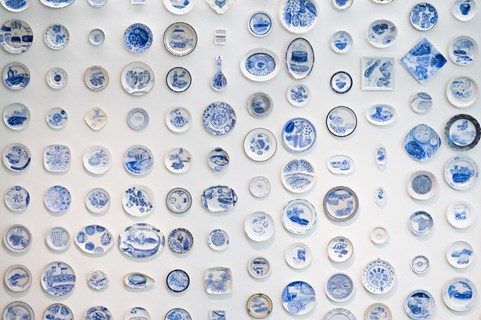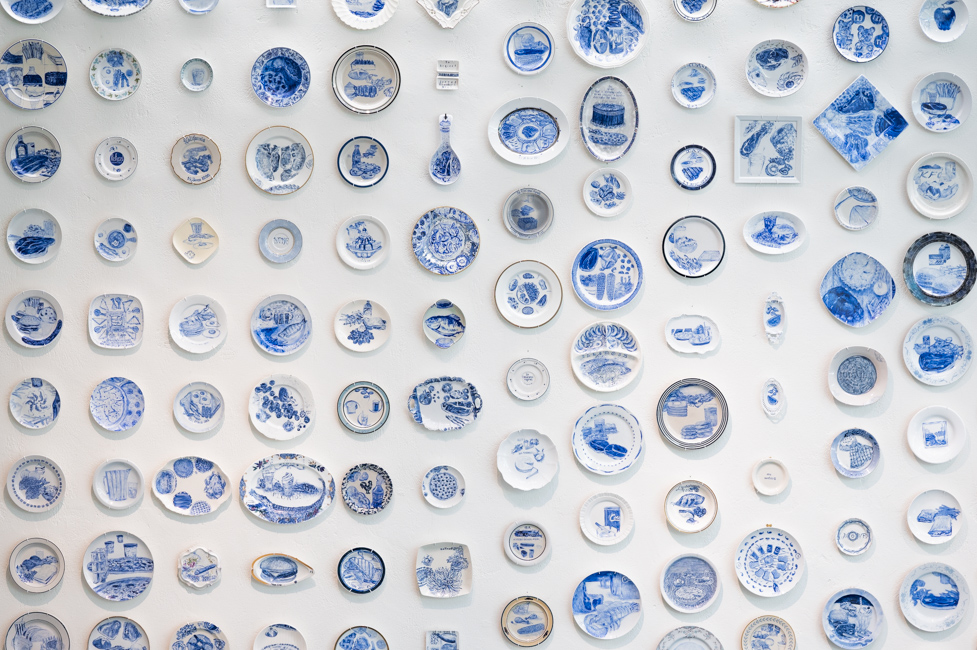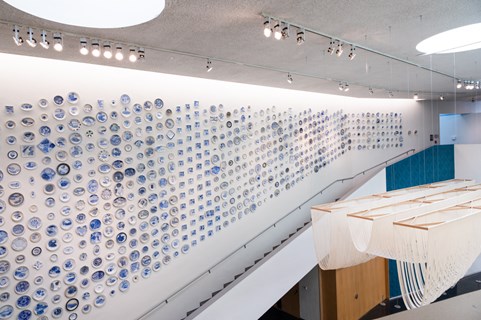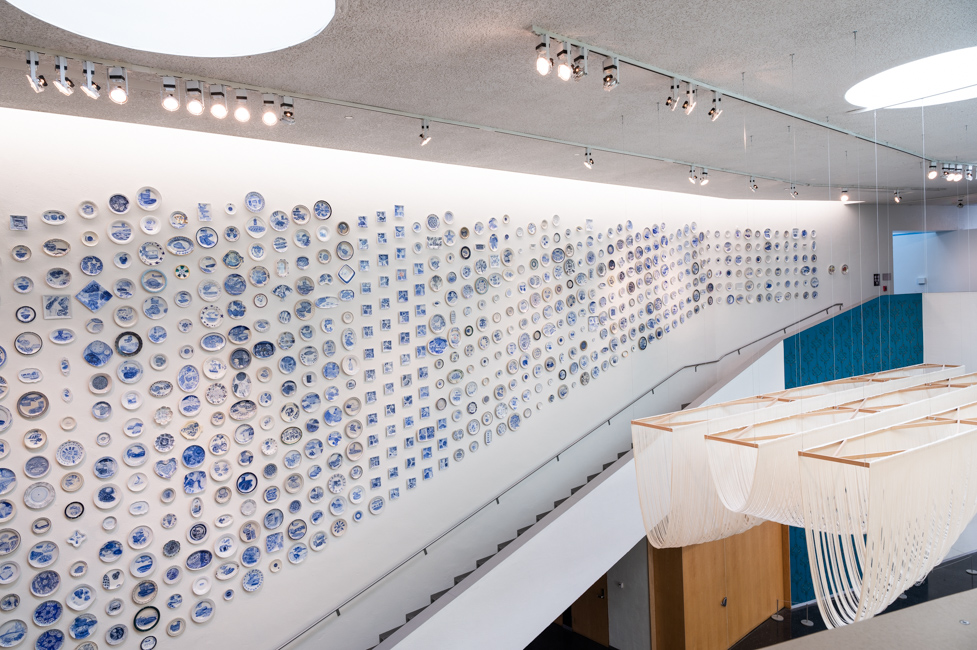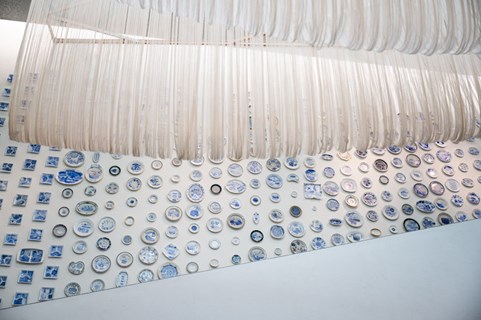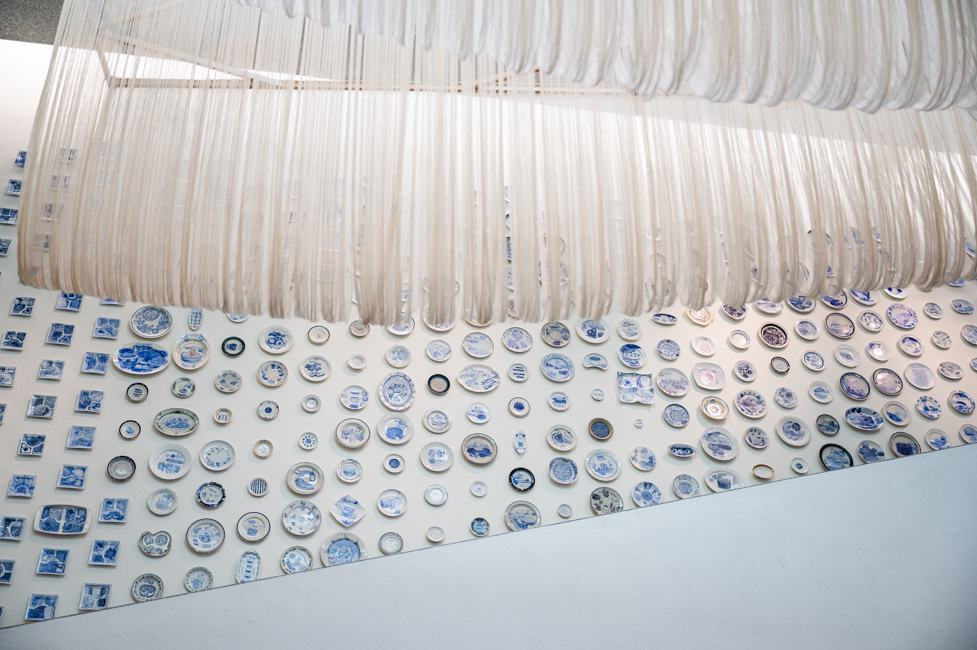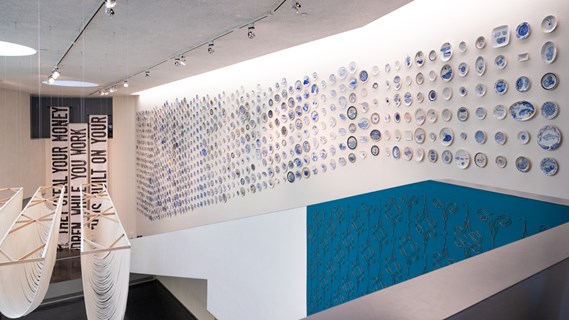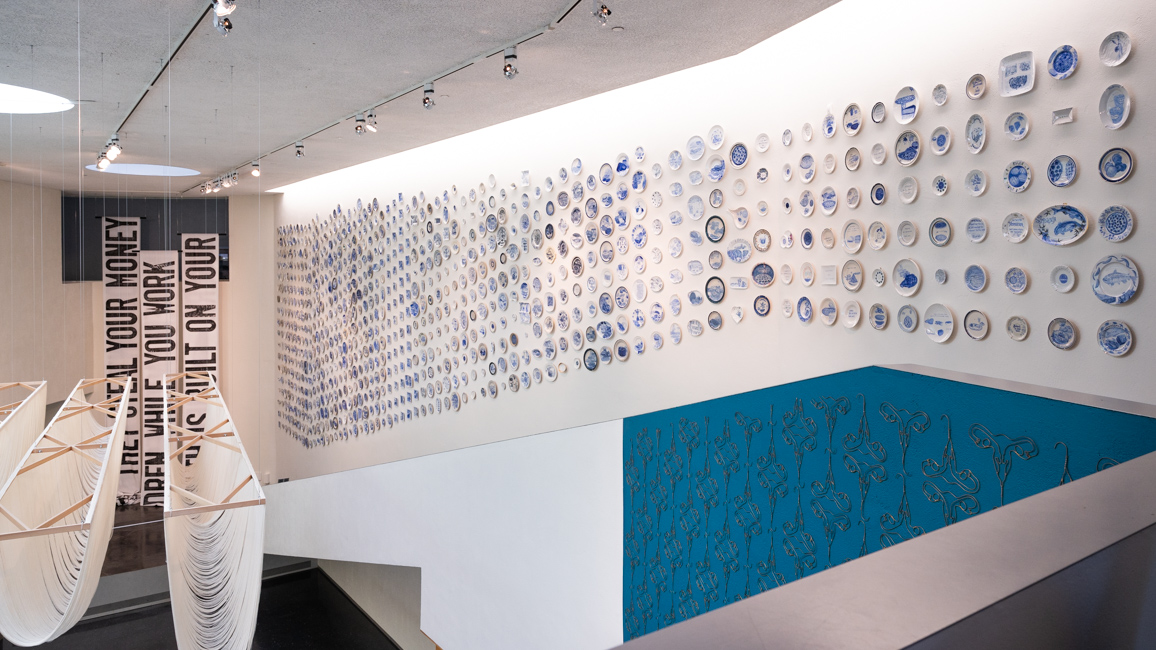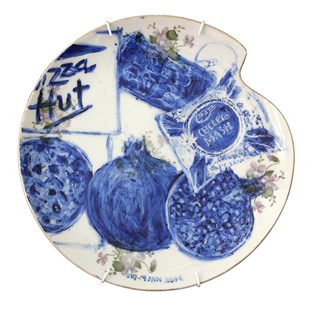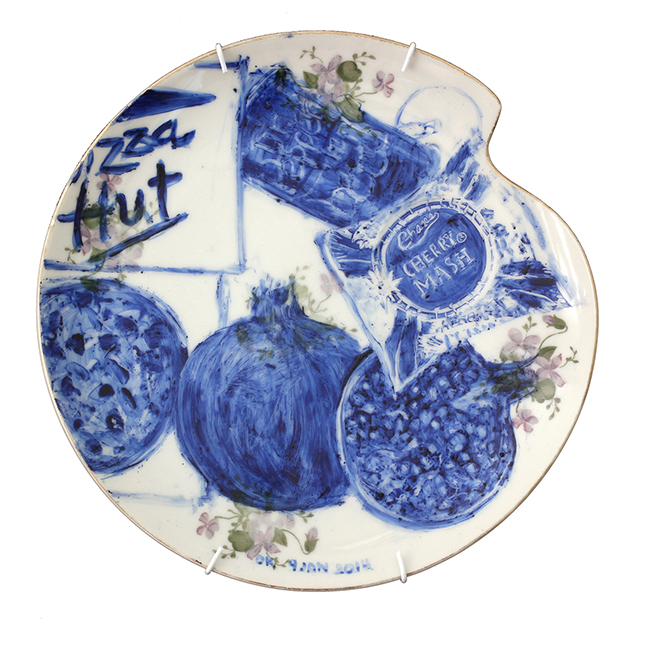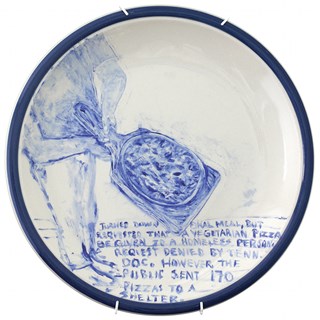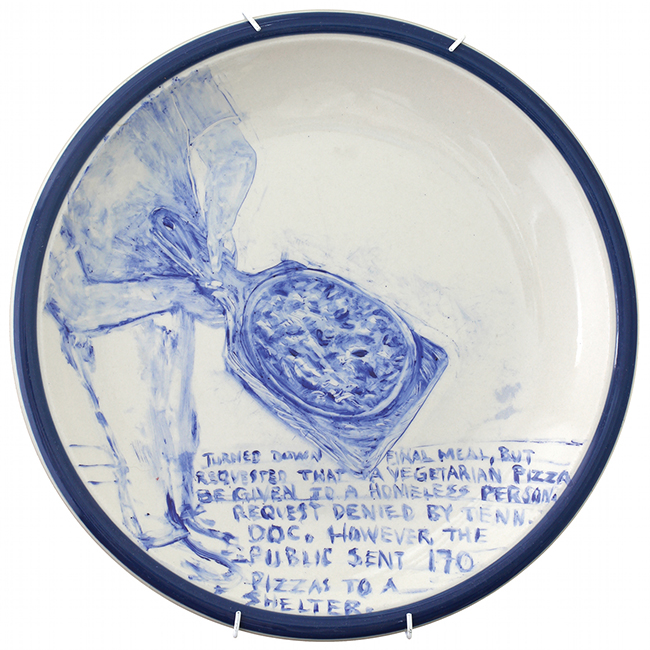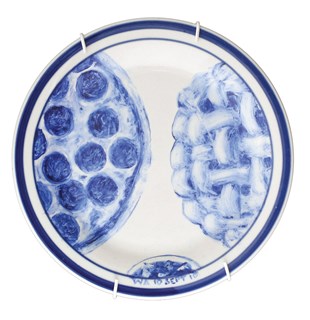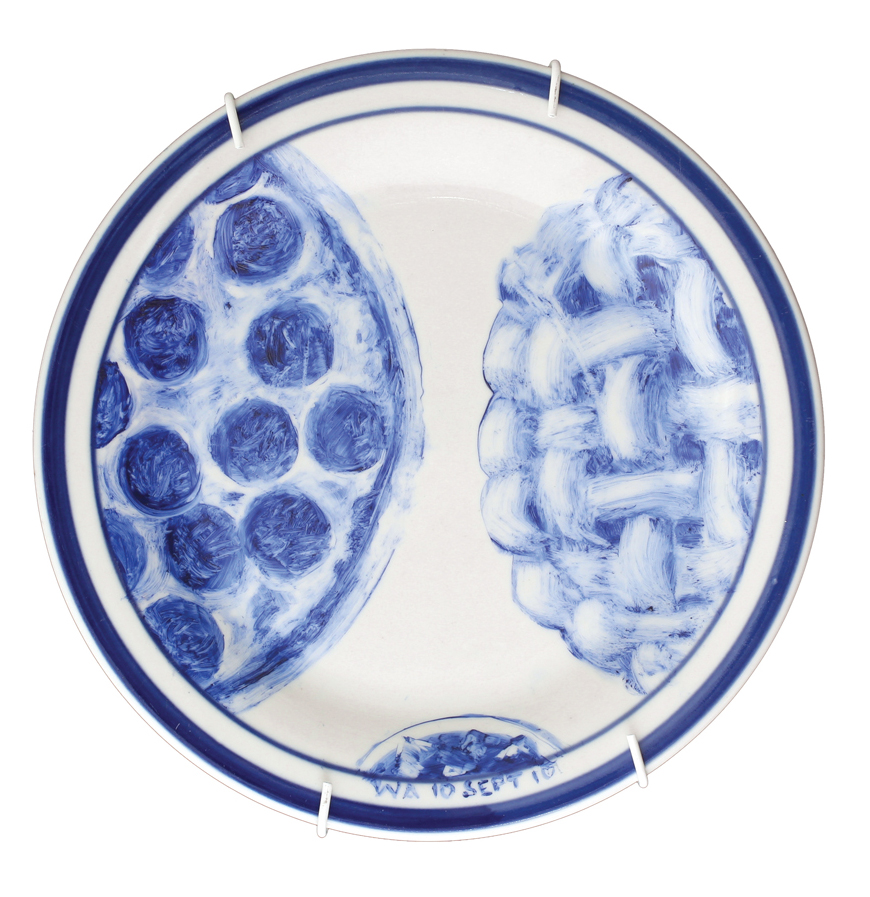Julie Green
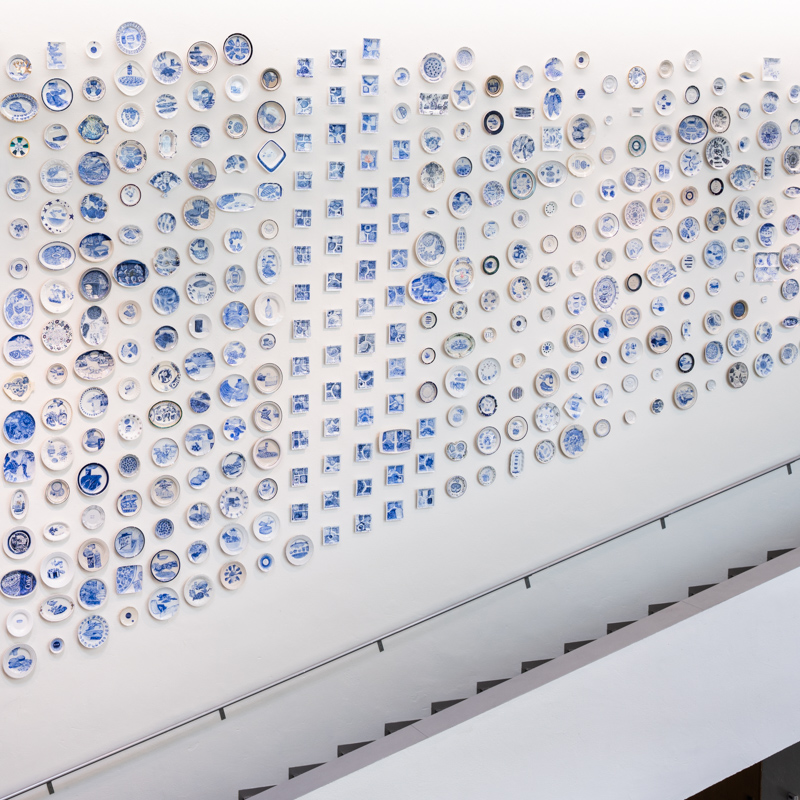
September 04, 2020 - September 25, 2022
Julie Green
The Last Supper
800 Plates
800 Plates Illustrating Final Meals of US Death Row Inmates
Growing up, I admired quilts and ceramics in our Iowa home, as well as the larger-than-life historical figures and 20’ American flag made with ears of colored corn in a neighbor’s yard. Appreciation for homemade and handmade led me to paint blue food. I once shared my family’s support of Nixon and capital punishment. Now I don’t.
Oklahoma has higher per capita executions than Texas. I taught there, and that is how I came to read final meal requests in the morning paper. The Last Supper illustrates the meal requests of U.S. death row inmates. Cobalt blue mineral paint is applied to second-hand ceramic plates, then kiln-fired to 1,400 degrees by technical advisors Toni Acock and Sandy Houtman.
Of the 1,521 US executions to date, 570 occurred in Texas, the only state that doesn’t allow a final meal selection. In Texas, inmates are served the standard prison meal of the day. In states that allow a choice, traditions and restrictions vary. There is no alcohol allowed anywhere. Cigarettes are officially banned but sometimes granted. Most selections are modest. This is not surprising, as many are limited to what is in the prison kitchen. Others provide meals from local venues. Pizza Hut, Wendy’s, and Long John Silver’s are frequently selected in Oklahoma, where their fifteen-dollar allowance is down from twenty in the late 1990s. California allows restaurant take-out up to fifty dollars. Historical menus from Folsom prison, shared by April Moore, point to the 733 inmates on death row today in California. State and date of execution are listed for each plate.
While looking for a permanent home for the project, unless capital punishment ends soon, I will continue until there are 1,000 plates. For me, a final meal request humanizes death row. Menus provide clues on region, race, and economic background. A family history becomes apparent when Indiana Department of Corrections adds, “He told us he never had a birthday cake so we ordered a birthday cake for him.”
Art can be a meditation. Why do we have this tradition of final meals, I wondered, after seeing a 1999 request for six tacos, six glazed donuts, and a cherry Coke. Twenty-one years later, I still wonder.
Julie Green
August 8, 2020
Death penalty information
In the past twenty years, the number of death sentences has dropped significantly; 1997 had 295 sentences, 2016 had 43. Since 1973, 166 people have been released from death row with evidence of their innocence.
Although the United States is considered a death penalty country, executions are rare or non-existent in much of the nation. Twenty-five of 53 jurisdictions in the US (50 states, the District of Columbia, the federal government, and the military) either do not have the death penalty or have not carried out an execution in at least 10 years.
1,521 total US state-sanctioned executions since 1976
| 570 | Texas | 12 | Nevada |
| 113 | Virginia | 12 | Illinois |
| 112 | Oklahoma | 7 | Utah |
| 99 | Florida | 5 | Maryland |
| 90 | Missouri | 5 | Washington |
| 76 | Georgia | 5 | South Dakota |
| 67 | Alabama | 4 | Nebraska |
| 56 | Ohio | 3 | Montana |
| 43 | North Carolina | 3 | Pennsylvania |
| 43 | South Carolina | 3 | Kentucky |
| 37 | Arizona | 2 | Idaho |
| 31 | Arkansas | 2 | Oregon |
| 28 | Louisiana | 1 | Colorado |
| 21 | Mississippi | 1 | Wyoming |
| 20 | Indiana | 1 | Connecticut |
| 16 | Delaware | 1 | New Mexico |
| 13 | California | 6 | US Federal Government |
| 13 | Tennessee |
States without the death penalty, and year abolished
Alaska (1957)
Colorado (2020)
Connecticut (2012)
Delaware (2016)
Hawaii (1957)
Illinois (2011)
Iowa (1965)
Maine (1887)
Maryland (2013)
Massachusetts (1984)
Michigan (1847)
Minnesota (1911)
New Hampshire (2019)
New Jersey (2007)
New Mexico (2009)
New York (2007)
North Dakota (1973)
Rhode Island (1984)
Vermont (1972)
Washington (2018)
West Virginia (1965)
Wisconsin (1853)
and Dist. of Columbia (1981)
States with moratoria
California, Colorado, Oregon, and Pennsylvania
Statistics as of July 17, 2020
Learn more at deathpenaltyinfo.org »
About the Artist
Julie Green (1961–2021) was a professor of art at Oregon State University and lived in the Willamette Valley with husband and artist Clay Lohmann and their small cat, Mini. Half of each year, usually winter months, she spent painting The Last Supper. A recipient of the Joan Mitchell Foundation Grant for Painters and Sculptors and the Hallie Ford Foundation Fellowship, Green was included in A World of Art published by Prentice Hall. Green had forty-two solo exhibitions in the U.S. and abroad at venues including The Armory Show in NYC, Upfor in Portland, The Block Museum at Northwestern University, Hunter Museum of American Art, and University of Liverpool Art Museum. Collections included State Library of Oregon, Spencer Museum of Art, Fidelity Investments, Athena Art Finance, and hundreds of private collections worldwide. Green’s work has been featured in publications including The New York Times, the Los Angeles Times, a Whole Foods mini-documentary, National Public Radio, and Ceramics Monthly. Green credited steadfast support from Clay Lohmann, Theo Downes-Le Guin at Upfor, and Oregon State University for making everything possible.
Professor Julie Green passed away at their home in Corvalis, Oregon on October 12, 2021 at the age of 60. Professor Green completed their twenty-two year The Last Supper project, totaling 1,000 plates, just over a month prior on September 4, 2021. Bellevue Arts Museum is honored to have worked with Professor Green and hosted their powerful installation.
Instagram: @juliegreen_art
Whole Foods Market documentary, The Last Supper, © 2012
